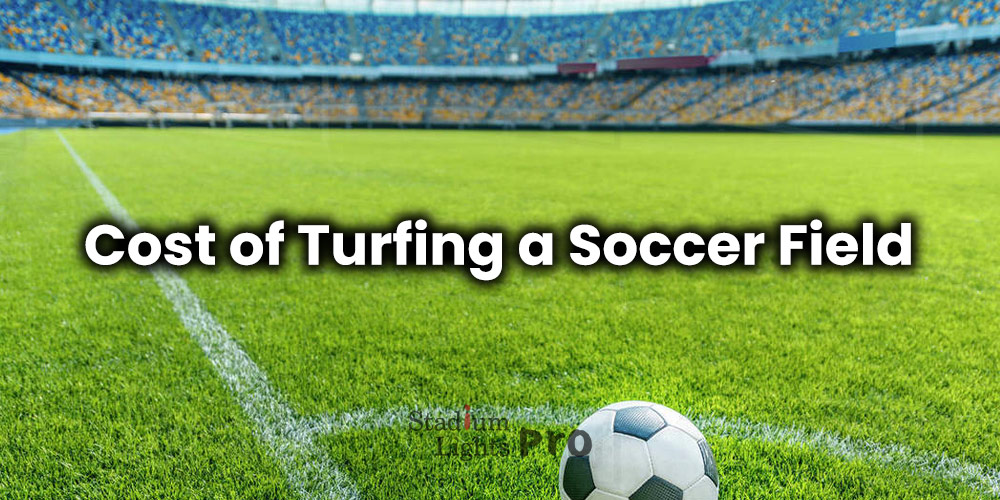This article is an introduction to the cost of turfing a soccer field, including materials, labor, permits, and maintenance. It is designed to provide an overview of the key factors that affect the cost of turf installation and to provide an estimate of the total cost for both professional and DIY installation.
It is suitable for anyone who is considering turfing a soccer field, including soccer clubs, schools, and municipalities. Whether you are a soccer coach, groundskeeper, or decision-maker, this article will give you the information you need to budget for and plan a turf installation project. It provides details on materials, labor, additional costs, and ongoing maintenance and also tips on how to make the right decision on the type of turf suitable for your area.
Table of Contents
ToggleHow much does it cost to install an artificial turf soccer field?
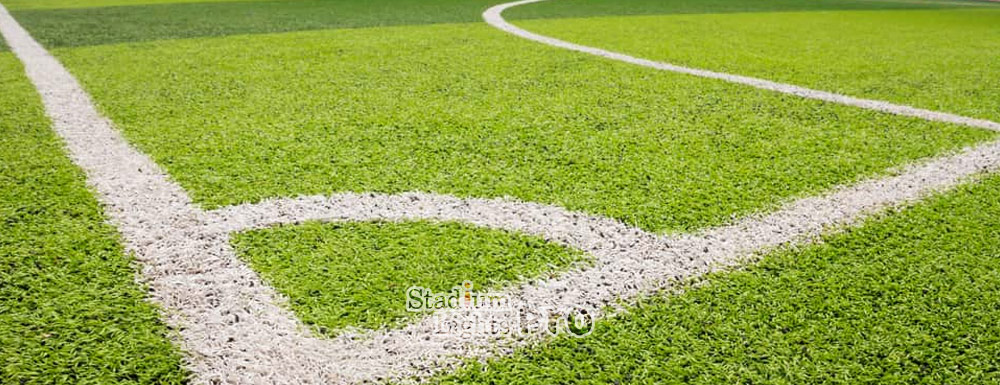
The cost to install an artificial soccer field turf can vary widely depending on a number of factors, including the size of the field, the type of turf used, and the location where the field will be installed. Some assumptions and estimates that could be used to calculate the cost might include:
- Field size – Assuming a standard adult-sized soccer field of approximately 100 yards by 50 yards, or about 5,000 square yards.
- Turf type – Assuming a mid-range turf option with a pile height of 1.5 inches and a face weight of about 50 ounces per square yard.
- Installation costs – Including excavation, grading, drainage, base preparation, and turf installation, with labor and materials factored in.
With these assumptions in mind, a rough estimate for the cost of installing an artificial soccer field turf might be around $30-$60 per square foot, or $150,000 to $300,000 for a soccer field of the size and quality specified above.
How much does it cost to install a natural turf soccer field?
Assuming a full size soccer field (about 100 yards x 50 yards), using a high-quality natural turf, and an average cost for labor and materials, the cost for installation could be around $300,000 to $500,000. However, again it highly depend on site condition, location, type of soil, and the climate.
What are the costs involved in laying soccer field turf?
The cost of turfing a soccer field can vary depending on a number of factors, including the size of the field, the type of turf selected, the quality of the materials, the cost of labor, and any additional costs such as permits and inspections. However, a rough estimate of the cost of turfing a soccer field can be broken down as follows:
Materials
The cost of materials will vary depending on the type of turf selected. Synthetic turf can range from $5 to $15 per square foot, while natural turf can range from $0.50 to $1.50 per square foot.
Labor
The cost of labor will vary depending on whether the installation is done professionally or as a DIY project. Professional installation can range from $1 to $3 per square foot, while DIY installation can be significantly lower.
Additional costs
Additional costs such as permits and inspections, drainage and irrigation systems can vary depending on the location and complexity of the project. Permits can range from a few hundred to a few thousand dollars and drainage and irrigation systems can range from $10,000 to $25,000.
Maintenance
Ongoing maintenance costs for synthetic turf may vary depending on the type of turf, it’s condition and usage. Synthetic turf requires less maintenance than natural grass but still requires annual grooming, leveling, and occasional replacement of infill.
Labor cost of turfing soccer field
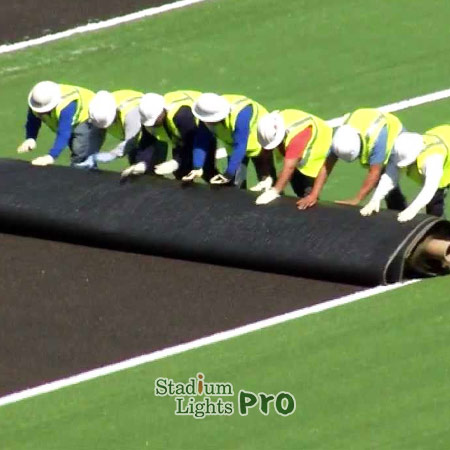 To calculate the overall labor cost, you would need to take into account the labor costs for each step of the process, including site preparation, base work, turf laying, infill installation, and finishing.
To calculate the overall labor cost, you would need to take into account the labor costs for each step of the process, including site preparation, base work, turf laying, infill installation, and finishing.
For professional installation, labor costs can range from $0.5 to $2 per square foot. So, for a soccer field that is 100,000 square feet, the labor cost would be between $50,000 to $200,000.
For DIY installation, labor cost will depend on the amount of hours and the cost of labor per hour. For example, if it takes 100 hours to complete the project and the labor cost per hour is $30, the overall labor cost would be $3,000.
Please note that these figures are rough estimates and actual labor costs can vary significantly depending on the location, size, complexity, and specific requirements of each project.
Site preparation
Site preparation involves preparing the site where the turf will be installed so that it is ready for the installation process. The cost of site preparation can range from $0.50 to $1.50 per square foot, depending on the size of the field, the complexity of the project, and the location of the field. It can include the following tasks:
- Grading – Leveling the soccer ground so that it is ready for the base work. This will ensure that water will drain properly, and that the field is level for playing.
- Removing existing vegetation – Removing any existing grass, weeds, or other vegetation from the area where the turf will be installed.
- Compacting the soil – Compacting the soil to make sure it is stable and ready for the base work.
- Excavation – Removing soil to reach a certain level or to install drainage, to change the shape of the field or to get rid of unwanted topography.
- Clearing debris – Removing any debris, rocks, or other material that could interfere with the installation process.
Base work
This can include tasks such as excavation, soil preparation, and installing a base layer of gravel or crushed stone. The cost of base work can range from $1 to $3 per square foot. Base work can include the following tasks:
- Soil preparation – Preparing the soil so that it is stable and ready for the soccer turf installation. This can include removing any loose or unstable soil, adding soil amendments such as sand or topsoil, and compacting the soil to create a stable base.
- Excavation – This is the process of removing soil to a certain level or to change the shape of the soccer field, or to install drainage systems. This can also include removing any existing vegetation, rocks, or other materials that could interfere with the installation process.
- Base Layer – A layer of material (such as crushed stone, gravel) that is installed on top of the soil to create a stable base for the turf. This layer helps with drainage, provide proper compaction and also helps protect the turf from the soil.
- Sub-base layer – Depending on the type of soil, drainage and the use of the soccer field, a layer of aggregate (such as crushed stone or gravel) may be placed on top of the base layer. This sub-base layer helps provide additional drainage, compaction and support for the turf.
Turf laying
This involves laying the turf on the prepared base and securing it in place. The cost of turf laying can range from $2 to $4 per square foot. The process of turf laying can include the following tasks:
- Measurement and layout – Measuring the field and marking out the area where the turf will be installed, to ensure proper coverage.
- Unrolling the turf – Unrolling the synthetic turf rolls or laying the natural turf on the prepared base.
- Cutting and fitting – Cutting the turf to the appropriate size and shape, and fitting it to the field. It may include trimming and shaping the turf to ensure proper fit and coverage.
- Seaming and joining – Joining and seaming the turf together, to ensure a seamless and smooth surface.
- Securing – Using various methods like nails, staples or adhesive to secure the turf to the base layer.
- Infill installation – This step is specific for synthetic turf, it involves the installation of infill material such as rubber crumbs or sand between the turf fibers to provide stability and cushioning
Infill installation
This involves installing infill material such as rubber crumbs or sand between the turf fibers to provide stability and cushioning. The cost of infill installation can range from $0.50 to $1 per square foot.
Infill is a material, such as rubber crumbs or sand, that is spread and brushed over the synthetic turf fibers after the soccer turf has been installed. It helps provide stability and cushioning for the field and also helps to protect the turf fibers from damage.
The infill material acts as a support and provides the necessary weight to the turf fibers, it also helps to maintain the standing position of the fibers, creating a more realistic look, and provides traction and energy return.
The infill installation process can include the following tasks:
- Measurement and layout – Measuring the field and determining the appropriate amount of infill material needed.
- Spreading – Spreading the infill material evenly over the synthetic turf fibers.
- Brushing – Brushing the infill material into the turf fibers to ensure proper distribution and coverage.
- Compact the infill – This step is to make sure the infill is evenly distributed and to make sure the turf fibers are standing up in their correct position.
- Final grooming – Groom the field, leveling and cleaning the surface, so that it’s ready to be used.
Finishing
Finishing is the last step in the process of turfing a soccer field. This includes tasks such as grooming and leveling the turf, and can cost an additional $0.50 to $1 per square foot.
- Grooming – Combing the turf fibers with a power broom or grooming machine to ensure that the turf is standing up and in its correct position.
- Leveling – Ensuring that the field is level and that the turf is smooth and even, with no bumps or dips.
- Cleaning – Cleaning any debris, dirt or infill that was not properly distributed or that was left over after installation and maintenance
- Final Inspection – A professional will inspect the field to ensure that the field meets the required standards and that it is safe for use.
Additional costs of laying soccer field turf
Cost of permits and inspections
The cost of permits and inspections for laying soccer field turf can vary depending on the location, size and complexity of the project. The cost of permits and inspections is typically associated with professional installations, as DIY installations may not be subject to the same regulations.
It can vary greatly depending on the local regulations in the area where the project is taking place. In some jurisdictions, a building permit may be required for a turf installation project, and the cost of this permit can vary from a few hundred dollars to several thousand dollars. The cost of permits can also depend on the size of the field and the scope of the project.
Cost of soccer field turf drainage and irrigation systems
Types of drainage systems
There are several different types of drainage systems that can be used for a soccer field turf. These include:
- Surface Drainage – Installation of surface drains, such as trenches or ditches, around the perimeter of the field. These surface drains collect water that runs off the field and carry it away to a nearby drainage area.
- Subsurface Drainage – Installation of a network of pipes or drainage channels beneath the field. These subsurface drains collect water that infiltrates the field and carries it away to a nearby drainage area. Subsurface drainage can be installed as a horizontal or vertical system.
- Sand-based drainage – It utilizes a sand layer underneath the synthetic turf field. Water that infiltrates the field is collected by the sand layer and drains into a network of perforated pipes installed underneath the sand layer, which then carries the water away.
- Geo-textile drainage system – This system utilizes a geotextile material that is laid beneath the turf, this material helps to collect water and direct it towards the drainage system.
Cost of installing & maintaining soccer turf drainage systems
Below are some rough estimates of the cost of installing different types of drainage systems:
| Type of soccer turf drainage system | Installation cost | Maintenance cost |
| Surface Drainage | $0.50 to $2.50 per square foot | $0.50 to $1.50 per linear foot |
| Subsurface Drainage | $1 to $3 per square foot | $0.50 to $2 per linear foot |
| Sand-based Drainage | $2 to $4 per square foot | $0.50 to $1 per square foot |
| Geo-textile Drainage | $1 to $2 per square foot | $0.50 to $1 per square foot |
Types of irrigation systems
- Surface Irrigation – Using sprays or sprinklers that are placed on the surface of the field to deliver water to the turf. This can include impact sprinklers, rotary sprinklers, or drip irrigation.
- Subsurface Irrigation – Installing a network of pipes or tubing beneath the field. Water is delivered through the pipes or tubing directly to the root zone of the turf. This can include subsurface drip irrigation (SDI) systems or sub-surface flood irrigation (SFI).
- Hybrid Irrigation – Combines the elements of surface and subsurface irrigation, they can be surface irrigation with subsurface irrigation which could be used as a supplement during hot days or drought.
- Automatic irrigation systems – They could be based on different technologies such as weather-based, soil moisture sensor, or smart irrigation systems. They operate according to set schedules and provide water as needed, with minimal human intervention.
Cost of installing & maintaining soccer turf irrigation systems
| Type of soccer turf irrigation system |
Installation cost | Maintenance cost |
| Surface Irrigation | $1 to $3 per square foot | $0.50 to $1 per sprinkler or nozzle |
| Subsurface Irrigation | $2 and $5 per square foot | $0.50 to $2 per linear foot |
| Hybrid Irrigation | $3 and $7 per square foot | $1 to $3 per square foot |
| Automatic irrigation systems | $5 to $12 per square foot | $0.50 to $2 per square foot |
Ongoing maintenance costs of soccer turf
Grooming and leveling
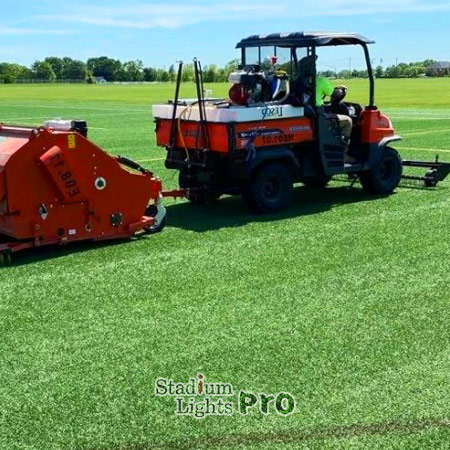 Grooming is the process of combing the fibers of the turf to make sure they are standing up and in the correct position. This can be done using a power broom or a specialized grooming machine. The process of grooming helps to redistribute the infill and keep the fibers upright, which improves the overall appearance of the field and ensures that it is safe for use.
Grooming is the process of combing the fibers of the turf to make sure they are standing up and in the correct position. This can be done using a power broom or a specialized grooming machine. The process of grooming helps to redistribute the infill and keep the fibers upright, which improves the overall appearance of the field and ensures that it is safe for use.
Leveling is the process of ensuring that the field is smooth and even, with no bumps or dips. This can be done using a laser level and grading equipment. The process of leveling helps to ensure that the field is safe for use by eliminating any tripping hazards, and it also improves the overall playing experience by providing a smooth surface for players to run on.
| Cost | |
| Grooming | $0.50 to $1 per square foot |
| Leveling | $1 to $3 per square foot |
Infill replacement
Infill replacement is the process of removing old or worn out infill material from a soccer field turf and replacing it with new infill material. The infill is the material that is spread on top of the turf fibers to help keep them upright, provide cushioning, and improve drainage. The infill is usually composed of sand, rubber, or organic materials such as cork or coconut fibers.
The frequency of infill replacement depends on several factors such as the usage of the field, environmental conditions, and the type of infill used. A field that is heavily used or exposed to extreme weather conditions may require infill replacement more frequently than a field that is used less or has more moderate weather conditions.
During the infill replacement process, the old infill is removed from the field using specialized equipment, such as a vacuum or power broom. The field is then cleaned and prepared for the new infill to be added. The new infill is spread evenly over the field and then compacted to ensure that it is properly distributed throughout the field.
| Types of soccer turf infill | Cost |
| Sand Infill | $0.10 to $0.25 per square foot |
| Rubber Infill | $0.50 to $1 per square foot |
| Organic Infill | $0.50 to $1 per square foot |
Pesticide and herbicide application
The cost of applying pesticides and herbicides to a soccer field turf can vary depending on the size of the field, the type of pesticides or herbicides used, and the location of the field.
Pesticides are chemicals that are used to control or eliminate pests, such as insects, mites, and other organisms that can damage the turf and create hazards for players. Pesticides are applied to the field using specialized equipment, such as sprayers, and can be applied as a liquid or a granular form.
Herbicides, also known as weed killers, are chemicals that are used to control or eliminate unwanted vegetation such as weeds that can grow on the field. They can be selective or non-selective, meaning they can target specific types of weeds or will kill any plant they come in contact with. Herbicides are applied to the field using specialized equipment, such as sprayers, and can be applied as a liquid or granular form.
Cost of maintaining natural soccer turf
Mowing
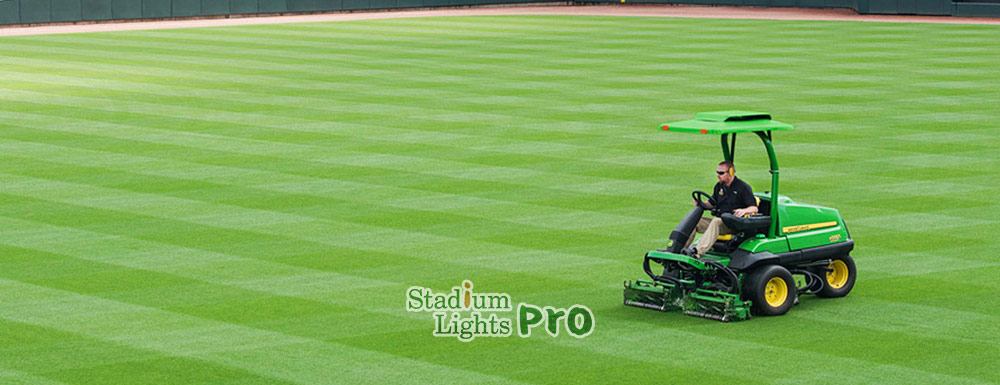
On average, the cost to mow a soccer turf can range from $100 to $600 or more. However, it’s recommended to check with local company that provide this service for more accurate pricing.
Mowing is a crucial aspect of maintaining a soccer field turf, whether it’s natural or synthetic. It refers to the process of cutting the grass using a specialized machine called a lawn mower. Mowing is necessary to keep the playing surface level and to ensure that the grass is of the appropriate height, so it will provide the appropriate playing conditions.
For natural grass fields, mowing is needed to keep the playing surface level and ensure that the grass is of the appropriate height. It’s essential to maintain the proper height of the grass, which usually varies between 20-30mm, to ensure that the field is safe for use and to provide an optimal playing experience for the players. Mowing also removes dead or yellowing grass leaves, which helps to promote healthy growth and improve the overall appearance of the field.
Frequency of mowing depends on several factors such as the type of grass used, weather conditions and the level of play on the field, among others. For example, a field that is heavily used or exposed to high temperatures will require more frequent mowing than a field that is used less or has milder weather conditions.
Fertilizing
Fertilizing involves applying a mixture of nutrients to the soil or turf in order to improve its health and growth. A professional sports turf management company can charge anywhere from $500 to $5,000 or more per application to fertilize a standard soccer turf field, depending on these factors. The frequency of application of fertilizer can also affect the cost.
If you choose to do it yourself, the cost of fertilizer and equipment can be significant, likely ranging from a few hundred to a few thousand dollars.
The purpose of fertilizing is to provide the grass plants with the necessary nutrients for optimal growth, color and health. Proper fertilization can help improve the overall quality of the turf, making it stronger and more resistant to disease and pests. Fertilizing can also help to repair damage from heavy use, or from environmental conditions such as drought, or heat.
There are several different types of fertilizer that can be used on a soccer field turf, such as slow-release fertilizers, liquid fertilizers, granular fertilizers and organic fertilizers. The right type of fertilizer to use will depend on the type of grass, the soil conditions, and the specific needs of the field.
The frequency of fertilizing depends on the type of grass and the specific needs of the field, as well as the climate and weather. In general, cool-season grasses will need to be fertilized more frequently than warm-season grasses.
Aeration
Aeration involves making small holes in the soil or turf to allow air, water, and nutrients to reach the roots of the grass. The cost can range from a few hundred dollars for a small soccer field to several thousand dollars for a large stadium.
Aeration can be done by using different tools such as a manual aerator with spikes or hollow tines, or by using a machine-powered aerator that punches small holes in the soil. This process can help to alleviate soil compaction, improve water and nutrient uptake, and promote deeper root growth. This can lead to a thicker, healthier turf that is more resilient to disease and pests, and better able to withstand heavy use.
The frequency of aeration will depend on the type of grass and the specific needs of the field, as well as the climate and weather. In general, cool-season grasses will need to be aerated more frequently than warm-season grasses.
Aeration is best done at the right time, usually during the growing season when the grass is actively growing. It’s suggested to follow proper techniques when aerating a soccer field turf and to use the correct equipment. Proper aeration can help to ensure that the field is safe for use and provides a good playing experience for the players, as well as prolong the lifespan of the field.
Watering
A rough estimate for a typical soccer field might be around $50 to $100 per watering, but this is a very rough estimate and actual costs could be significantly higher or lower. It is also worth noting that the cost of maintaining a natural turf field, including watering, fertilization, and mowing, can be quite high, which is one reason why many sports fields have switched to artificial turf.
Proper watering is essential for the health and survival of the grass, it helps the grass to absorb nutrients and prevent the turf from drying out and becoming diseased. The frequency and amount of watering will depend on a number of factors, such as the type of grass, the soil conditions, the weather, and the specific needs of the field. In general, fields that are located in hot and dry climates will require more frequent watering than fields that are located in cooler and wetter climates.
There are several different ways to water a soccer field turf, such as using a hose or a watering can, or by installing an irrigation system. Irrigation systems can include above-ground sprinklers, underground sprinklers, or drip irrigation. The right method to use will depend on the type of grass, the soil conditions, and the specific needs of the field.
Pesticide and herbicide application
The cost of applying pesticides and herbicides to a soccer field turf can vary depending on the size of the field, the type of pesticides or herbicides used, and the location of the field.
Pesticides are chemicals that are used to control or eliminate pests, such as insects, mites, and other organisms that can damage the turf and create hazards for players. Pesticides are applied to the field using specialized equipment, such as sprayers, and can be applied as a liquid or a granular form.
Herbicides, also known as weed killers, are chemicals that are used to control or eliminate unwanted vegetation such as weeds that can grow on the field. They can be selective or non-selective, meaning they can target specific types of weeds or will kill any plant they come in contact with. Herbicides are applied to the field using specialized equipment, such as sprayers, and can be applied as a liquid or granular form.
| Types of application | Cost |
| Pesticide | $0.50 to $1 per square foot |
| Herbicide | $0.80 to $1.5 per square foot |
Conclusion
Installing and maintaining a soccer field turf, whether it is natural or synthetic, is a significant investment that requires proper planning and execution. It involves various steps including site preparation, turf laying, infill installation, finishing, grading and base work. Additionally, it’s essential to consider the ongoing maintenance costs such as mowing, fertilizing, aeration, watering, irrigation and drainage system, pest and weed control, as well as grooming and leveling, infill replacement and permits and inspections.
Each step of the process and maintenance cost can vary depending on the size of the field, the type of grass used, and the location of the field. It is highly recommended to consult with professionals to get a detailed cost estimate for a specific project, as well as take into consideration the type of soil, previous treatments, and the state of the field before and after installation. Maintaining a soccer field turf requires regular attention and care to ensure a safe and playable field that can last for many years.
Get a free soccer field turf consultation service
If you’re considering replacing or installing a new soccer field turf, it is highly recommended to plan and budget for the project to ensure its long-term success. One of the best ways to do this is by getting a professional consultation. We are happy to provide a free consultation service for anyone looking to install or replace their soccer field turf.
During the consultation, our team of experts will assess your field’s current condition, discuss your specific needs and requirements, and provide you with a detailed breakdown of the costs involved for the project. We will also take into account factors such as the size of the field, the type of grass used, and the location of the field, in order to provide you with an accurate cost estimate.
Not only will our consultation service provide you with valuable insights and expert advice, but you can also take advantage of our discounted quotes for installing or replacing your soccer field turf. We are committed to providing our clients with the best quality products and services at competitive prices.
Don’t hesitate to contact us today to schedule your free consultation and to take advantage of our discounted quotes for soccer field turf installation or replacement. Our team is dedicated to helping you make an informed decision and ensure the success of your project.

